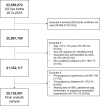Trends in Prepregnancy Obesity and Association With Adverse Pregnancy Outcomes in the United States, 2013 to 2018
- PMID: 34431359
- PMCID: PMC8649260
- DOI: 10.1161/JAHA.120.020717
Trends in Prepregnancy Obesity and Association With Adverse Pregnancy Outcomes in the United States, 2013 to 2018
Abstract
Background The prevalence of obesity in the population has increased in parallel with increasing rates of adverse pregnancy outcomes (APOs). Quantifying contemporary trends in prepregnancy obesity and associations with interrelated APOs (preterm birth, low birth weight, and pregnancy-associated hypertension) together and individually can inform prevention strategies to optimize cardiometabolic health in women and offspring. Methods and Results We performed a serial, cross-sectional study using National Center for Health Statistics birth certificate data including women aged 15 to 44 years with live singleton births between 2013 and 2018, stratified by race/ethnicity (non-Hispanic White, non-Hispanic Black, Hispanic, and non-Hispanic Asian). We quantified the annual prevalence of prepregnancy obesity (body mass index ≥30.0 kg/m2; body mass index ≥27.5 kg/m2 if non-Hispanic Asian). We then estimated adjusted associations using multivariable logistic regression (odds ratios and population attributable fractions) for obesity-related APOs compared with normal body mass index (18.5-24.9 kg/m2; 18.5-22.9 kg/m2 if non-Hispanic Asian). Among 20 139 891 women, the prevalence of prepregnancy obesity increased between 2013 and 2018: non-Hispanic White (21.6%-24.8%), non-Hispanic Black (32.5%-36.2%), Hispanic (26.0%-30.5%), and non-Hispanic Asian (15.3%-18.6%) women (P-trend < 0.001 for all). Adjusted odds ratios (95% CI) for APOs associated with obesity increased between 2013 and 2018, and by 2018, ranged from 1.27 (1.25-1.29) in non-Hispanic Black to 1.94 (1.92-1.96) in non-Hispanic White women. Obesity was most strongly associated with pregnancy-associated hypertension and inconsistently associated with preterm birth and low birth weight. Population attributable fractions of obesity-related APOs increased over the study period: non-Hispanic White (10.6%-14.7%), non-Hispanic Black (3.7%-6.9%), Hispanic (7.0%-10.4%), and non-Hispanic Asian (7.4%-9.7%) women (P-trend < 0.01 for all). Conclusions The prevalence of prepregnancy obesity and burden of obesity-related APOs have increased, driven primarily by pregnancy-associated hypertension, and vary across racial/ethnic subgroups.
Keywords: adverse pregnancy outcomes; obesity; population attributable fraction; primordial prevention; racial disparities.
Conflict of interest statement
None.
Figures




References
-
- Martin JA, Hamilton BE, Osterman MJ, Driscoll AK. Births: final data for 2018. Natl Vital Stat Rep. 2019;68:1–47. - PubMed
-
- Benjamin EJ, Muntner P, Alonso A, Bittencourt MS, Callaway CW, Carson AP, Chamberlain AM, Chang AR, Cheng S, Das SR, et al. Heart disease and stroke statistics‐2019 update: a report from the American Heart Association. Circulation. 2019;139:e56–e528. DOI: 10.1161/CIR.0000000000000659. - DOI - PubMed
Publication types
MeSH terms
Grants and funding
LinkOut - more resources
Full Text Sources
Medical

